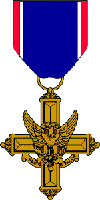|
 |
|
Distinguished Service
Cross Army |
|
The
Distinguished Service Cross was established by President
Woodrow Wilson on January 2, 1918. General Pershing,
Commander-in-Chief of the Expeditionary Forces in France, had
recommended that recognition other than the Medal of Honor, be
authorized for the Armed Forces of the United States for
service rendered, in like manner, to that awarded by the
European Armies. The request for establishment of the medal
was forwarded from the Secretary of War to the President in a
letter dated December 28, 1917. The Act of Congress
establishing this award (193-65th Congress) dated July 9, 1918
is contained in Title 10 United States Code (USC) 3742. The
establishment of the Distinguished Service Cross was
promulgated in War Department General Order No. 6, dated
January 12, 1918. (amended by act of 25 July
1963).
The
Distinguished Service Cross was established by
President Woodrow Wilson on January 2, 1918. General
Pershing, Commander-in-Chief of the Expeditionary
Forces in France, had recommended that recognition
other than the Medal of Honor, be authorized for the
Armed Forces of the United States for service |
rendered, in like manner, to that awarded by the
European Armies. The request for establishment of the medal
was forwarded from the Secretary of War to the President in a
letter dated December 28, 1917. The Act of Congress
establishing this award (193-65th Congress) dated July 9, 1918
is contained in Title 10 United States Code (USC) 3742. The
establishment of the Distinguished Service Cross was
promulgated in War Department General Order No. 6, dated
January 12, 1918. (amended by act of 25 July
1963).
The first design of the Distinguished Service Cross was cast
and manufactured by the United States Mint at Philadelphia.
The die was cast from the approved design prepared by
Lieutenant Aymar E. Embry, Engineers Officer Reserve Corps.
Upon examination of the first medals struck at the Mint, it
was considered advisable to make certain minor changes to add
to the beauty and the attractiveness of the medal. Due to the
importance of the time element involved in furnishing the
decorations to General Pershing, one hundred of the medals
were struck from the original design and numbered 1 to 100.
These medals were furnished with the provision that these
crosses be replaced when the supply of the second design was
accomplished which would also be numbered 1 to 100.
The Distinguished Service Cross is awarded to
a person who, while serving in any capacity with the Army,
distinguishes himself or herself by extraordinary heroism not
justifying the award of a Medal of Honor; while engaged in an
action against an enemy of the Unites States; while engaged in
military operations involving conflict with an
opposing/foreign force; or while serving with friendly foreign
forces engaged in an armed conflict against an opposing Armed
Force in which the United States is not a belligerent party.
The act or acts of heroism must have been so notable and have
involved risk of life so extraordinary as to set the
individual apart from his or her comrades.
The Distinguished Service Cross is the second highest
decoration for valor in war and evolved from the Certificate
of Merit of 1847. This certificate was intended to be
conferred only on private soldiers; NCOs received commissions
for outstanding service and heroism; officers received brevet
promotions. Authority to award the
Distinguished Service Cross is held by the Commanding
General of a US Army Force serving in the rank of General and
the Chief of Staff, Army and may not be further delegated.
Successive awards are denoted by Oak Leaf Clusters. |

